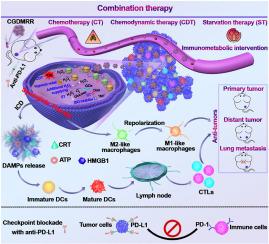基于双金属过氧化物的纳米疗法,用于免疫代谢干预和诱导免疫原性细胞死亡,以增强癌症免疫疗法。
IF 12.8
1区 医学
Q1 ENGINEERING, BIOMEDICAL
引用次数: 0
摘要
免疫疗法改变了癌症治疗,但其疗效往往受到肿瘤微环境(TME)免疫抑制特性的限制,而肿瘤微环境主要受癌细胞代谢的影响。在这些代谢途径中,吲哚胺-2,3-二氧化酶(IDO)途径尤为重要,因为它在很大程度上促进了肿瘤微环境的抑制并影响了免疫细胞的活性。此外,诱导肿瘤细胞的免疫原性细胞死亡(ICD)可以逆转免疫抑制的TME,从而提高免疫疗法的疗效。在此,我们开发了一种基于过氧化铜铈纳米颗粒的新型双金属过氧化物基纳米药物 CGDMRR。这些纳米治疗药物可缓解肿瘤缺氧,并以靶向方式递送治疗药物,如 1-甲基色氨酸(1MT)、葡萄糖氧化酶(GOx)和多柔比星(Dox)。该设计旨在缓解肿瘤缺氧,减少 IDO 通路的免疫抑制作用,促进 ICD。CGDMRR 可有效抑制 4T1 肿瘤的生长,并利用免疫代谢干预和诱导 ICD 的疗法激发抗肿瘤免疫反应。此外,当 CGDMRR 与临床认证的抗 PD-L1 抗体结合使用时,其抑制肿瘤生长的功效会得到增强。由于激活了全身性的抗肿瘤免疫,这种疗效的提高超越了单侧肿瘤模型,也影响到双侧肿瘤和肺转移瘤。这项研究强调了 CGDMRR 在乳腺癌免疫疗法中增强 PD-L1 阻断疗效的潜力。本文章由计算机程序翻译,如有差异,请以英文原文为准。

Bimetallic peroxide-based nanotherapeutics for immunometabolic intervention and induction of immunogenic cell death to augment cancer immunotherapy
Immunotherapy has transformed cancer treatment, but its efficacy is often limited by the immunosuppressive characteristics of the tumor microenvironment (TME), which are predominantly influenced by the metabolism of cancer cells. Among these metabolic pathways, the indoleamine 2,3-dioxygenase (IDO) pathway is particularly crucial, as it significantly contributes to TME suppression and influences immune cell activity. Additionally, inducing immunogenic cell death (ICD) in tumor cells can reverse the immunosuppressive TME, thereby enhancing the efficacy of immunotherapy. Herein, we develop CGDMRR, a novel bimetallic peroxide-based nanodrug based on copper-cerium peroxide nanoparticles. These nanotherapeutics are engineered to mitigate tumor hypoxia and deliver therapeutics such as 1-methyltryptophan (1MT), glucose oxidase (GOx), and doxorubicin (Dox) in a targeted manner. The design aims to alleviate tumor hypoxia, reduce the immunosuppressive effects of the IDO pathway, and promote ICD. CGDMRR effectively inhibits the growth of 4T1 tumors and elicits antitumor immune responses by leveraging immunometabolic interventions and therapies that induce ICD. Furthermore, when CGDMRR is combined with a clinically certified anti-PD-L1 antibody, its efficacy in inhibiting tumor growth is enhanced. This improved efficacy extends beyond unilateral tumor models, also affecting bilateral tumors and lung metastases, due to the activation of systemic antitumor immunity. This study underscores CGDMRR's potential to augment the efficacy of PD-L1 blockade in breast cancer immunotherapy.
求助全文
通过发布文献求助,成功后即可免费获取论文全文。
去求助
来源期刊

Biomaterials
工程技术-材料科学:生物材料
CiteScore
26.00
自引率
2.90%
发文量
565
审稿时长
46 days
期刊介绍:
Biomaterials is an international journal covering the science and clinical application of biomaterials. A biomaterial is now defined as a substance that has been engineered to take a form which, alone or as part of a complex system, is used to direct, by control of interactions with components of living systems, the course of any therapeutic or diagnostic procedure. It is the aim of the journal to provide a peer-reviewed forum for the publication of original papers and authoritative review and opinion papers dealing with the most important issues facing the use of biomaterials in clinical practice. The scope of the journal covers the wide range of physical, biological and chemical sciences that underpin the design of biomaterials and the clinical disciplines in which they are used. These sciences include polymer synthesis and characterization, drug and gene vector design, the biology of the host response, immunology and toxicology and self assembly at the nanoscale. Clinical applications include the therapies of medical technology and regenerative medicine in all clinical disciplines, and diagnostic systems that reply on innovative contrast and sensing agents. The journal is relevant to areas such as cancer diagnosis and therapy, implantable devices, drug delivery systems, gene vectors, bionanotechnology and tissue engineering.
 求助内容:
求助内容: 应助结果提醒方式:
应助结果提醒方式:


